-
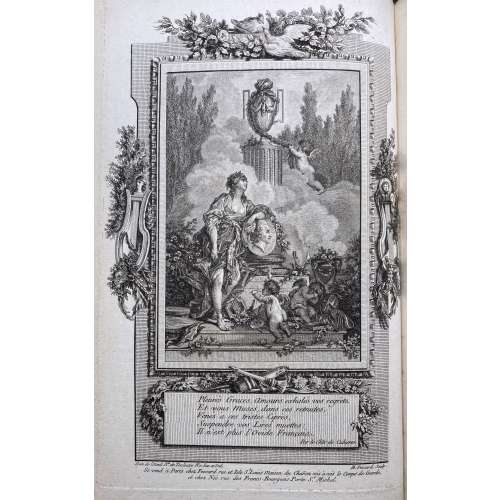 Title page: LES | BAISERS , | PRÉCÉDES | DU MOIS DE MAI, | POËME. | [vignette] | A LA HAYE , | Et se trouve à Paris | Chez Lambert , Imprimeur, rue de la Harpe. | Et Delalain , rue de la Comédie Françoise. | M. DCC. LXX Size: 8vo; 24.5 x 15.5 cm; Binding by Hippolyte Duru – stamp at the back of the front end paper DURU, 1855; full red calf, boards decorated in gilt, raised bands and gilt decorations in compartments, gilt lettering, AEG, peacock marbled end papers, text and illustrations printed on Holland paper. Collation: 2 ffls, engraved half-title by N. Ponce after Ch. Eisen, frontispiece by Etienne Fessard after Claude-Jean-Baptiste Hoin (French, 1750 – 1817) w/guard tissue, t.p. by J. Aliamet after Ch. Eisen, Réflexions préliminaires: A8, B4; 'Le Mois de Mai' half-title, imprim. note on verso, frontispice by De Longueil after Ch. Eisen w/guard tissue, A4 C-F(8) H4; 2bfls. Frontispiece by Etienne Fessard is unique in this edition. Pagination: [2] 3-24, [27]/28, 5/6, 31/32 31/34 11/12 37-119 [120], 22 head-pieces after Ch. Eisen and 22 end-pieces after Marillier, engraved by Baquoy, Binet, Delaunay, Lingée, De Longueil, Masquelier, Massard, and Née. Mistakes in pagination likely confirms first printing first edition. Catalogue raisonné: Cohen, De Ricci (1912): 308-311). Artists: Charles Eisen (French, 1720–1778); Clément Pierre Marillier (French, 1740–1808), and Claude-Jean-Baptiste Hoin (French, 1750–1817). Engravers: Jacques Aliamet (French, 1726–1788); Jean Charles Baquoy (French, 1721–1777); Louis Binet (French, 1744–about 1800); Nicolas Delaunay (French, 1739–1792); Etienne Fessard (French, 1714–1777); Charles Louis Lingée (French, 1748–1819); Joseph de Longueil (French, 1730–1792); Louis Joseph Masquelier (French, 1741–1811); Jean Massard (1740–1822); François Denis Née (French, 1735–1818); Nicholas Ponce (French, 1746–1831).
Title page: LES | BAISERS , | PRÉCÉDES | DU MOIS DE MAI, | POËME. | [vignette] | A LA HAYE , | Et se trouve à Paris | Chez Lambert , Imprimeur, rue de la Harpe. | Et Delalain , rue de la Comédie Françoise. | M. DCC. LXX Size: 8vo; 24.5 x 15.5 cm; Binding by Hippolyte Duru – stamp at the back of the front end paper DURU, 1855; full red calf, boards decorated in gilt, raised bands and gilt decorations in compartments, gilt lettering, AEG, peacock marbled end papers, text and illustrations printed on Holland paper. Collation: 2 ffls, engraved half-title by N. Ponce after Ch. Eisen, frontispiece by Etienne Fessard after Claude-Jean-Baptiste Hoin (French, 1750 – 1817) w/guard tissue, t.p. by J. Aliamet after Ch. Eisen, Réflexions préliminaires: A8, B4; 'Le Mois de Mai' half-title, imprim. note on verso, frontispice by De Longueil after Ch. Eisen w/guard tissue, A4 C-F(8) H4; 2bfls. Frontispiece by Etienne Fessard is unique in this edition. Pagination: [2] 3-24, [27]/28, 5/6, 31/32 31/34 11/12 37-119 [120], 22 head-pieces after Ch. Eisen and 22 end-pieces after Marillier, engraved by Baquoy, Binet, Delaunay, Lingée, De Longueil, Masquelier, Massard, and Née. Mistakes in pagination likely confirms first printing first edition. Catalogue raisonné: Cohen, De Ricci (1912): 308-311). Artists: Charles Eisen (French, 1720–1778); Clément Pierre Marillier (French, 1740–1808), and Claude-Jean-Baptiste Hoin (French, 1750–1817). Engravers: Jacques Aliamet (French, 1726–1788); Jean Charles Baquoy (French, 1721–1777); Louis Binet (French, 1744–about 1800); Nicolas Delaunay (French, 1739–1792); Etienne Fessard (French, 1714–1777); Charles Louis Lingée (French, 1748–1819); Joseph de Longueil (French, 1730–1792); Louis Joseph Masquelier (French, 1741–1811); Jean Massard (1740–1822); François Denis Née (French, 1735–1818); Nicholas Ponce (French, 1746–1831). -
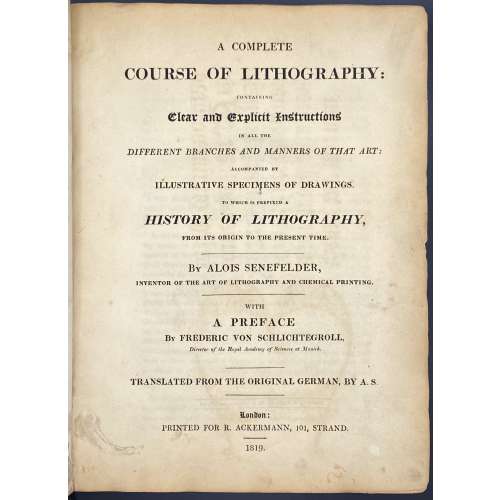 Title: A COMPLETE | COURSE OF LITHOGRAPHY: | CONTAINING | Clear and Explicit Instructions | IN ALL THE | DIFFERENT BRANCHES AND MANNERS OF THAT ART | ACCOMPANIED BY | ILLUSTRATIVE SPECIMENS OF DRAWINGS. | TO WHICH IS PREFIXED A | HISTORY OF LITHOGRAPHY, | FROM ITS ORIGIN TO THE PRESENT TIME. | By ALOIS SENEFELDER, | INVENTOR OF THE ART OF LITHOGRAPHY AND CHEMICAL PRINTING. | WITH | A PREFACE | By FREDERIC VON SCHLICHTEGROLL, |Director of the Royal Academy of Sciences at Munich. | TRANSLATED FROM THE ORIGINAL GERMAN, BY A.S. | London: | PRINTED FOR R. ACKERMANN, 101 STRAND. | 1819. || Pagination: [i-iii] iv-xxviii, [4] [1] 2-342. Collation: 4to; [a]-d4, B-2U4 2X2, +14 lithographed plates by Ackermann (incl. 1 folding, 1 colour frontispiece and 1 portrait of A. Senefelder); plates opposite to pp. [i], [1], 193, 198, 203, 228, 232 (fold.), 256, 258, 264, 269, 290, 302, and 305. Binding: By Anne Krawitz (Philadelphia, PA), 27.5 x 21 cm, modern full mottled calf, boards ruled in gilt, flat spine, compartments ruled in gilt, crimson label with gilt lettering to spine, printed on wove paper; round book-plate to front paste-down “TWM, The Whitehead Library”. Edition: 1st in English. Ref.: MET: Accession Number: Ref.20; RCT: RCIN 1195886; Contributors: Alois Senefelder (German, 1771 – 1834) – author of the original and translator. Friedrich Schlichtegroll (German, 1765 – 1822) – author of preface. William Clowes (British, 1779 – 1847) – printer. Rudolph Ackermann (German-British, 1764 – 1834) – publisher and lithographer. Samuel Prout (British, 1783 – 1852) Maximilian Joseph, King of Bavaria (German, 1756 –1825) – dedicatee.
Title: A COMPLETE | COURSE OF LITHOGRAPHY: | CONTAINING | Clear and Explicit Instructions | IN ALL THE | DIFFERENT BRANCHES AND MANNERS OF THAT ART | ACCOMPANIED BY | ILLUSTRATIVE SPECIMENS OF DRAWINGS. | TO WHICH IS PREFIXED A | HISTORY OF LITHOGRAPHY, | FROM ITS ORIGIN TO THE PRESENT TIME. | By ALOIS SENEFELDER, | INVENTOR OF THE ART OF LITHOGRAPHY AND CHEMICAL PRINTING. | WITH | A PREFACE | By FREDERIC VON SCHLICHTEGROLL, |Director of the Royal Academy of Sciences at Munich. | TRANSLATED FROM THE ORIGINAL GERMAN, BY A.S. | London: | PRINTED FOR R. ACKERMANN, 101 STRAND. | 1819. || Pagination: [i-iii] iv-xxviii, [4] [1] 2-342. Collation: 4to; [a]-d4, B-2U4 2X2, +14 lithographed plates by Ackermann (incl. 1 folding, 1 colour frontispiece and 1 portrait of A. Senefelder); plates opposite to pp. [i], [1], 193, 198, 203, 228, 232 (fold.), 256, 258, 264, 269, 290, 302, and 305. Binding: By Anne Krawitz (Philadelphia, PA), 27.5 x 21 cm, modern full mottled calf, boards ruled in gilt, flat spine, compartments ruled in gilt, crimson label with gilt lettering to spine, printed on wove paper; round book-plate to front paste-down “TWM, The Whitehead Library”. Edition: 1st in English. Ref.: MET: Accession Number: Ref.20; RCT: RCIN 1195886; Contributors: Alois Senefelder (German, 1771 – 1834) – author of the original and translator. Friedrich Schlichtegroll (German, 1765 – 1822) – author of preface. William Clowes (British, 1779 – 1847) – printer. Rudolph Ackermann (German-British, 1764 – 1834) – publisher and lithographer. Samuel Prout (British, 1783 – 1852) Maximilian Joseph, King of Bavaria (German, 1756 –1825) – dedicatee. -
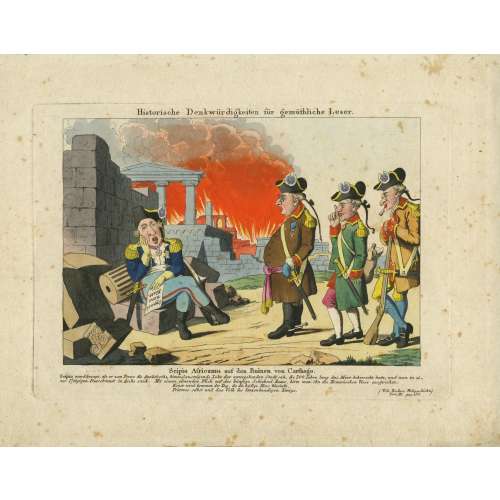 Hand-coloured etching from the series Historische Denkwürdigkeiten für gemütliche Leser by an anonymous German artist, printed c. 1815.
Hand-coloured etching from the series Historische Denkwürdigkeiten für gemütliche Leser by an anonymous German artist, printed c. 1815. -
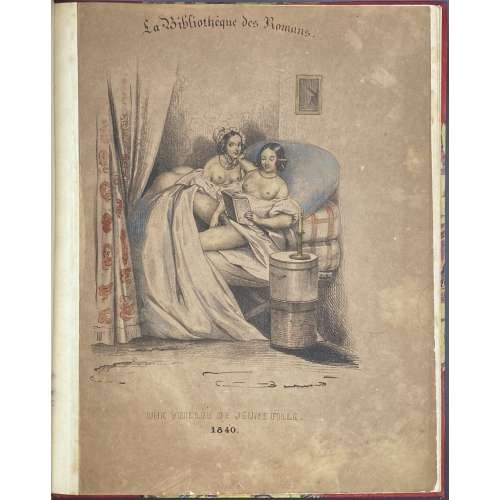 Description: Pictorial album 29.7 x 24 cm, bound in ¾ red morocco over marbled boards with gilt lettering “LA BIBLIOTHÈQUE DES ROMANS” and raised bands to spine; marbled endpapers, two flyleaves, tan original wrapper lettered “La Bibliothèque des Romans. (gothic, arch) | {colour vignette} | UNE VEILLÉE DE JEUNE FILLE. | 1840. || Six hand-coloured lithographs, each in a double-rule border with the series title above it and image title below. Sequential numbers are hand-inscribed within the border in the upper-right corner. Frame 23.5 x 18.3 cm, image 21.5 x 16.5 cm. Three flyleaves at the end. A bookplate to front pastedown: “GERARD NORDMANN EX-LIBRIS”. Content:
Description: Pictorial album 29.7 x 24 cm, bound in ¾ red morocco over marbled boards with gilt lettering “LA BIBLIOTHÈQUE DES ROMANS” and raised bands to spine; marbled endpapers, two flyleaves, tan original wrapper lettered “La Bibliothèque des Romans. (gothic, arch) | {colour vignette} | UNE VEILLÉE DE JEUNE FILLE. | 1840. || Six hand-coloured lithographs, each in a double-rule border with the series title above it and image title below. Sequential numbers are hand-inscribed within the border in the upper-right corner. Frame 23.5 x 18.3 cm, image 21.5 x 16.5 cm. Three flyleaves at the end. A bookplate to front pastedown: “GERARD NORDMANN EX-LIBRIS”. Content:- Front wrapper (title-page)
- SŒUR ANNE (Sister Anne)
- LA GRISETTE (The grisette)
- LÉONIDE OU LA VIEILLE DE SURÊNE (Léonide or the old lady of Surêne)
- LA PUCELLE DE BELLEVILLE (The maid of Belleville)
- MON VOISIN RAYMOND (My neighbor Raymond)
- LE COCU (The cuckold)
-
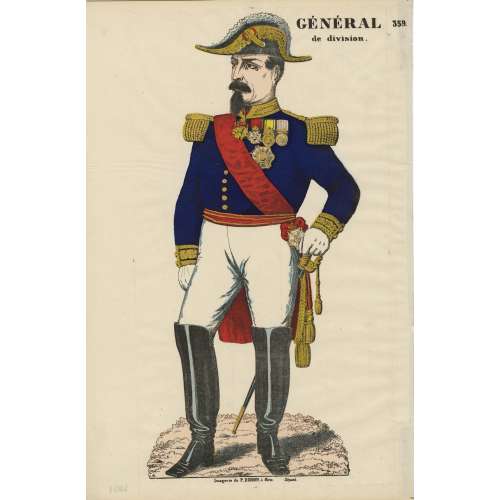 Hand-coloured woodcut on wove paper, 430 x 285 mm; black ink stamp “5051” to reverse. Top right: "GÉNÉRAL | de division." — "359." Bottom: "Imagerie de DIDION, à Metz. Déposé." Paulin Didion (French, 1831 – 1879) – publisher/printer.
Hand-coloured woodcut on wove paper, 430 x 285 mm; black ink stamp “5051” to reverse. Top right: "GÉNÉRAL | de division." — "359." Bottom: "Imagerie de DIDION, à Metz. Déposé." Paulin Didion (French, 1831 – 1879) – publisher/printer. -
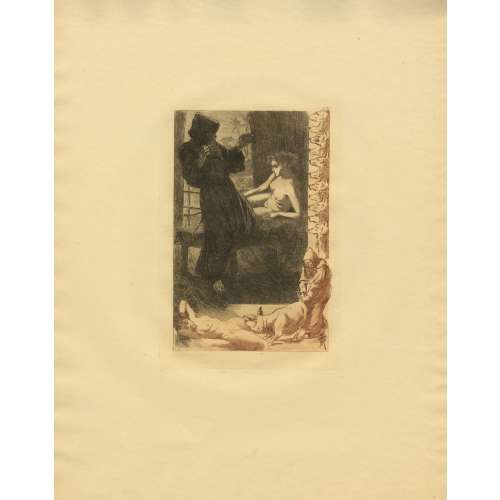 Set of 21 etchings by Martin van Maele for the English edition of ‘Thais’ by Anatole France published in London by Charles Carrington in 1901. Printed on vowe paper without a watermark in two colours with the black image and sepia historiated border. All etchings are inscribed with the artist's monogram; one of the etchings bears inscriptions ORGUEIL, LUXURE, DOUTE (mirror image). Dimensions: sheet: 317 x 250 mm; plate: 170 x 115 mm; image: 155 x 100 mm. Catalogue raisonné: S. A. Perry: № 64. Per Perry, the edition was printed in 500 copies on 'handmade paper watermarked 'Van Gelder'. Contributor: Martin van Maële [Martin, Maurice François Alfred] (French, 1863 – 1926)
Set of 21 etchings by Martin van Maele for the English edition of ‘Thais’ by Anatole France published in London by Charles Carrington in 1901. Printed on vowe paper without a watermark in two colours with the black image and sepia historiated border. All etchings are inscribed with the artist's monogram; one of the etchings bears inscriptions ORGUEIL, LUXURE, DOUTE (mirror image). Dimensions: sheet: 317 x 250 mm; plate: 170 x 115 mm; image: 155 x 100 mm. Catalogue raisonné: S. A. Perry: № 64. Per Perry, the edition was printed in 500 copies on 'handmade paper watermarked 'Van Gelder'. Contributor: Martin van Maële [Martin, Maurice François Alfred] (French, 1863 – 1926) -
 A two-volume set: (1) Thomas Hugo. The Bewick Collector. A Descriptive Catalogue of the Works of Thomas and John Bewick; Including cuts, in various states, for Books and Pamphlets, Private Gentlemen, Public Companies, Exhibitions, Races, Newspapers, Shop Cards, Invoice Heads, Bar Bills, Coal Certificates, Broadsides, and other miscellaneous purposes, and Wood Blocks. With an Appendix of Portraits, Autographs, Works of Pupils, etc., etc. The whole described from the Originals contained in the largest and most perfect collection ever formed, and illustrated with a hundred and twelve cuts. — London: Lovell Reeve and Co., MDCCCLXVI [1866]. — [Printed by] J. E. Taylor and Co., printers. — pp.: [i-v] vi-xxiii [xxiv], [1] 2-562. (2) Thomas Hugo. The Bewick Collector. A Supplement to a Descriptive Catalogue of the Works of Thomas and John Bewick; Consisting of additions to the various divisions of cuts, wood blocks. etc., enumerated in that work. The whole described from the Originals contained in the largest and most perfect collection ever formed, and illustrated with a hundred and eighty cuts. — London: L. Reeve and Co, MDCCCLXVIII [1868]. — [Printed by] J. E. Taylor and Co., printers. — pp.: [i-vii] viii-xxxii, [1] 2-353. Both volumes in 8vo, 22.5 x 14.5 cm, hardcover. Contemporary dark brown half morocco, gilt-ruled, with 5 raised bands, gilt titles and decoration to spine, and marbled paper over boards. Top edge gilt; marbled endpapers. Binding splitting at pp.80/81 of the 1st volume. Armorial bookplate of Ralph Hart Tweddle to front pastedown. Ralph Hart Tweddle (1843 – 1895) was a British mechanical engineer, known particularly for inventing the portable hydraulic riveter, which greatly facilitated the construction of boilers, bridges and ships.
A two-volume set: (1) Thomas Hugo. The Bewick Collector. A Descriptive Catalogue of the Works of Thomas and John Bewick; Including cuts, in various states, for Books and Pamphlets, Private Gentlemen, Public Companies, Exhibitions, Races, Newspapers, Shop Cards, Invoice Heads, Bar Bills, Coal Certificates, Broadsides, and other miscellaneous purposes, and Wood Blocks. With an Appendix of Portraits, Autographs, Works of Pupils, etc., etc. The whole described from the Originals contained in the largest and most perfect collection ever formed, and illustrated with a hundred and twelve cuts. — London: Lovell Reeve and Co., MDCCCLXVI [1866]. — [Printed by] J. E. Taylor and Co., printers. — pp.: [i-v] vi-xxiii [xxiv], [1] 2-562. (2) Thomas Hugo. The Bewick Collector. A Supplement to a Descriptive Catalogue of the Works of Thomas and John Bewick; Consisting of additions to the various divisions of cuts, wood blocks. etc., enumerated in that work. The whole described from the Originals contained in the largest and most perfect collection ever formed, and illustrated with a hundred and eighty cuts. — London: L. Reeve and Co, MDCCCLXVIII [1868]. — [Printed by] J. E. Taylor and Co., printers. — pp.: [i-vii] viii-xxxii, [1] 2-353. Both volumes in 8vo, 22.5 x 14.5 cm, hardcover. Contemporary dark brown half morocco, gilt-ruled, with 5 raised bands, gilt titles and decoration to spine, and marbled paper over boards. Top edge gilt; marbled endpapers. Binding splitting at pp.80/81 of the 1st volume. Armorial bookplate of Ralph Hart Tweddle to front pastedown. Ralph Hart Tweddle (1843 – 1895) was a British mechanical engineer, known particularly for inventing the portable hydraulic riveter, which greatly facilitated the construction of boilers, bridges and ships. -
![[RASPE, Rudolf Erich]. The Travels and Surprising Adventures of Baron Munchausen. / Illustrated with 37 curious engravings, from the Baron's own designs, and five woodcuts, by G. Cruikshank. — London: William Tegg, 1869. — xii + [10] + 268 pp.](https://varshavskycollection.com/wp-content/uploads/2021/02/LIB-2269.2019-5-scaled-500x500.jpeg) Half-title: BARON MUNCHAUSEN Title: THE TRAVELS | AND | SURPRISING ADVENTURES | OF | BARON MUNCHAUSEN. | ILLUSTRATED WITH | THIRTY-SEVEN CURIOUS ENGRAVINGS, | FROM | THE BARON'S OWN DESIGNS, | AND FIVE WOODCUTS, | BY G. CRUIKSHANK. | [device] | LONDON : WILLIAM TEGG. | 1869.|| [RASPE, Rudolf Erich]. The Travels and Surprising Adventures of Baron Munchausen. / Illustrated with 37 curious engravings, from the Baron's own designs, and five woodcuts, by G. Cruikshank. — London: William Tegg, 1869. Pagination: xii + [10] + 268 pp, 23 plates: hand-coloured engraved frontispiece, 5 woodcuts by Cruikshank, other b/w etchings, two folding plates. Binding: 19 x 13 cm; hardbound, 8vo, early 20th century 3/4 dark plum morocco gilt-ruled, raised bands, title label, gilt lettering, gilt in compartments, top edge gilt. Catalogue raisonné: A. Cohn: #584, p. 172. This edition is an identical re-issue of the 1867 edition.
Half-title: BARON MUNCHAUSEN Title: THE TRAVELS | AND | SURPRISING ADVENTURES | OF | BARON MUNCHAUSEN. | ILLUSTRATED WITH | THIRTY-SEVEN CURIOUS ENGRAVINGS, | FROM | THE BARON'S OWN DESIGNS, | AND FIVE WOODCUTS, | BY G. CRUIKSHANK. | [device] | LONDON : WILLIAM TEGG. | 1869.|| [RASPE, Rudolf Erich]. The Travels and Surprising Adventures of Baron Munchausen. / Illustrated with 37 curious engravings, from the Baron's own designs, and five woodcuts, by G. Cruikshank. — London: William Tegg, 1869. Pagination: xii + [10] + 268 pp, 23 plates: hand-coloured engraved frontispiece, 5 woodcuts by Cruikshank, other b/w etchings, two folding plates. Binding: 19 x 13 cm; hardbound, 8vo, early 20th century 3/4 dark plum morocco gilt-ruled, raised bands, title label, gilt lettering, gilt in compartments, top edge gilt. Catalogue raisonné: A. Cohn: #584, p. 172. This edition is an identical re-issue of the 1867 edition. -
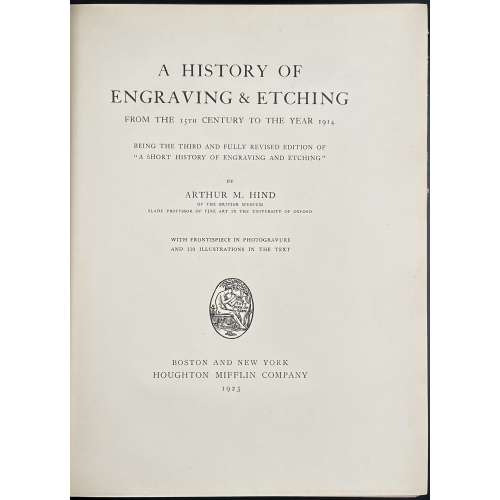 Title: A HISTORY OF | ENGRAVING & ETCHING | FROM THE 15TH CENTURY TO THE YEAR 1914 | BEING THE THIRD AND FULLY REVISED EDITION OF | “A SHORT HISTORY OF ENGRAVING AND ETCHING” | BY | ARTHUR M. HIND | OF THE BRITISH MUSEUM | SLADE PROFESSOR OF FINE ART IN THE UNIVERSITY OF OXFORD | WITH FRONTISPIECE IN PHOTOGRAVURE | AND 110 ILLUSTRATIONS IN THE TEXT | {publisher’s device} | BOSTON AND NEW YORK | HOUGHTON MIFFLIN COMPANY | 1923 || Pagination: [i-iv] v-xiii. [2] – blank / abbrev., [2] 3-487 [488], frontis. w/tissue guard, ills.; Appendices: I. Classified list of engravers (p. 343-392); II. General bibliography (p. 393-419); III. Index of engravers and individual bibliography (p. 420-487). Collation: π10 B-2H8 2I4, frontispiece (extr.), 110 in-text illustrations. Binding: 25.8 x 20 cm, crimson cloth, blind triple-fillet to top and bottom of the front board, same in gilt to spine, gilt lettering to spine, top edge gilt, fore-edge untrimmed. Contributors: Arthur Mayger Hind (British, 1880 – 1957) – author. Houghton Mifflin Company (Boston, 1864) – publisher. R & R. Clark, Ltd. (Edinburgh, 1846) – printer. Note: It is marked as the 3rd edition of A short history of engraving and etching. Indeed, A short history of engraving & etching for the use of collectors and students with full bibliography, classified list and index of engravers was published by Constable in London and Houghton Mifflin Co. in Boston, in 1908 and then in 1911. However, it is hard to consider an almost completely new book "a 3rd edition".
Title: A HISTORY OF | ENGRAVING & ETCHING | FROM THE 15TH CENTURY TO THE YEAR 1914 | BEING THE THIRD AND FULLY REVISED EDITION OF | “A SHORT HISTORY OF ENGRAVING AND ETCHING” | BY | ARTHUR M. HIND | OF THE BRITISH MUSEUM | SLADE PROFESSOR OF FINE ART IN THE UNIVERSITY OF OXFORD | WITH FRONTISPIECE IN PHOTOGRAVURE | AND 110 ILLUSTRATIONS IN THE TEXT | {publisher’s device} | BOSTON AND NEW YORK | HOUGHTON MIFFLIN COMPANY | 1923 || Pagination: [i-iv] v-xiii. [2] – blank / abbrev., [2] 3-487 [488], frontis. w/tissue guard, ills.; Appendices: I. Classified list of engravers (p. 343-392); II. General bibliography (p. 393-419); III. Index of engravers and individual bibliography (p. 420-487). Collation: π10 B-2H8 2I4, frontispiece (extr.), 110 in-text illustrations. Binding: 25.8 x 20 cm, crimson cloth, blind triple-fillet to top and bottom of the front board, same in gilt to spine, gilt lettering to spine, top edge gilt, fore-edge untrimmed. Contributors: Arthur Mayger Hind (British, 1880 – 1957) – author. Houghton Mifflin Company (Boston, 1864) – publisher. R & R. Clark, Ltd. (Edinburgh, 1846) – printer. Note: It is marked as the 3rd edition of A short history of engraving and etching. Indeed, A short history of engraving & etching for the use of collectors and students with full bibliography, classified list and index of engravers was published by Constable in London and Houghton Mifflin Co. in Boston, in 1908 and then in 1911. However, it is hard to consider an almost completely new book "a 3rd edition". -
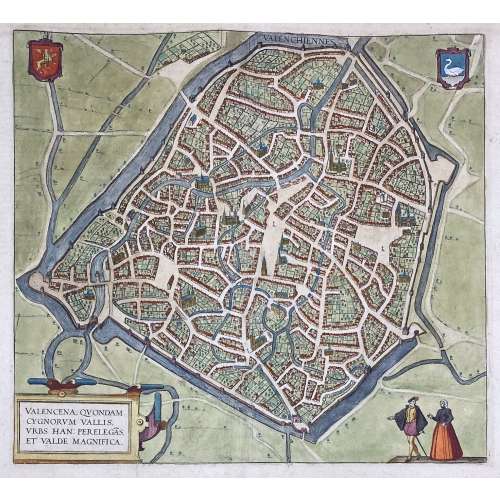 VALENCENA, QUONDAM | CYGNORUM VALLIS | URBS HAN: PERELEGÃS | ET VALDE MAGNIFICA. ||
VALENCENA, QUONDAM | CYGNORUM VALLIS | URBS HAN: PERELEGÃS | ET VALDE MAGNIFICA. ||Engraved and hand-coloured map of Valenciennes first produced for Braun & Hogenberg's 6-volume Civitates orbis terrarum edition in 1570.
English translation of the text printed on verso: "The Loire, an exceedingly well-known river in France, flows directly past the city and is very beneficial for trade. The fields surrounding the city are very fertile, and for this reason, the city is also called the granary throughout France, just as in earlier times Sicily was the granary of Rome. A famous wine also grows in this soil, which is exported from here not only throughout France but to all the countries in Europe. [...] The French spoken here is pure and uncorrupted, which is also the reason why so many foreigners settle here. For some are here for trade, others for study and others again to acquire the language, but also many without doubt for both these last two reasons, [...] and Germans, in particular, send their children here." [by Barry Lawrence Ruderman Antique Maps Inc.]
Dimensions: Sheet: 39.8 x 53.5 cm; Image: 35.2 x 38.5 cm.
Probably published in Cologne is 1612-18 by Petrum à Brachel: [Coloniae Agrippinae: apud Petrum à Brachel, sumptibus auctorum, 1612-1618]. Ref: LOC.Georg Braun [Brunus; Bruin] (German, 1541 – 1622).
Frans Hogenberg (Flemish-German, 1535 – 1590).
Abraham Ortelius [Ortels; Orthellius; Wortels] (Dutch, 1527 – 1598). -
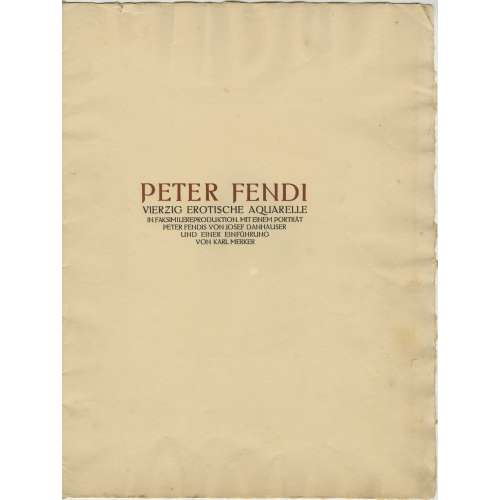 Six in-folio leaves, 2o, incl. title-page, engraved portrait of P. Fendi after Josef Danhauser, 4 pages of printed text, and 10 of 40 colour photomechanical reproductions of Fendi’s watercolour plates (205 x 140 mm), mounted on vellum paper with blind stamp (398 x 305 mm) in a parchment-backed flapped album (defective), gilt-stamped, with straps. Limited edition of 600 copies. The publisher is not stated but is sometimes attributed to C. W. Stern in Vienna. Limitation statement and imprint missing. Title-page (brown and black): PETER FENDI | VIERZIG EROTISCHE AQUARELLE | IN FAKSIMILEREPRODUKTION. MIT EINEM PORTRÄT | PETER FENDIS VON JOSEF DANHAUSER | UND EINER EINFÜHRUNG | VON KARL MERKER || Catalogue Raisonné: Nordmann II № 198, p.96. Contributors: Peter Fendi (Austrian, 1796 – 1842) Josef Danhauser (Austian, 1805 – 1845) Karl Merker – author/introduction.
Six in-folio leaves, 2o, incl. title-page, engraved portrait of P. Fendi after Josef Danhauser, 4 pages of printed text, and 10 of 40 colour photomechanical reproductions of Fendi’s watercolour plates (205 x 140 mm), mounted on vellum paper with blind stamp (398 x 305 mm) in a parchment-backed flapped album (defective), gilt-stamped, with straps. Limited edition of 600 copies. The publisher is not stated but is sometimes attributed to C. W. Stern in Vienna. Limitation statement and imprint missing. Title-page (brown and black): PETER FENDI | VIERZIG EROTISCHE AQUARELLE | IN FAKSIMILEREPRODUKTION. MIT EINEM PORTRÄT | PETER FENDIS VON JOSEF DANHAUSER | UND EINER EINFÜHRUNG | VON KARL MERKER || Catalogue Raisonné: Nordmann II № 198, p.96. Contributors: Peter Fendi (Austrian, 1796 – 1842) Josef Danhauser (Austian, 1805 – 1845) Karl Merker – author/introduction. -
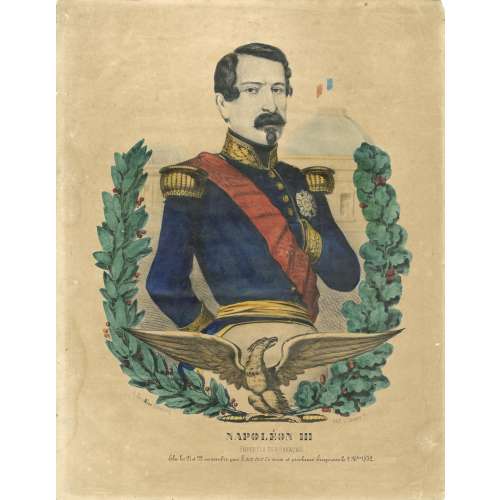 Hand-coloured lithography on wove paper, 380 x 298 mm; black ink stamp “4912” to reverse. On stone left: "A, Paris Miné Éditeur, imp.;" right: "Lith. R. St. Jacques. 41." Bottom center: "Napoléon III"; below: "EMPEREUR DES FRANÇAIS", under: "Élu les 21 el 22 novembre par 8,000,000 de voix et proclamé Empereur le 2 Xbre 1852." Printer/publisher: Miné, éditeur, imprimeur en lithographie, Rue Saint-Jacques, 41. Napoleon III [Charles-Louis Napoléon Bonaparte] (French, 1808 – 1873)
Hand-coloured lithography on wove paper, 380 x 298 mm; black ink stamp “4912” to reverse. On stone left: "A, Paris Miné Éditeur, imp.;" right: "Lith. R. St. Jacques. 41." Bottom center: "Napoléon III"; below: "EMPEREUR DES FRANÇAIS", under: "Élu les 21 el 22 novembre par 8,000,000 de voix et proclamé Empereur le 2 Xbre 1852." Printer/publisher: Miné, éditeur, imprimeur en lithographie, Rue Saint-Jacques, 41. Napoleon III [Charles-Louis Napoléon Bonaparte] (French, 1808 – 1873) -
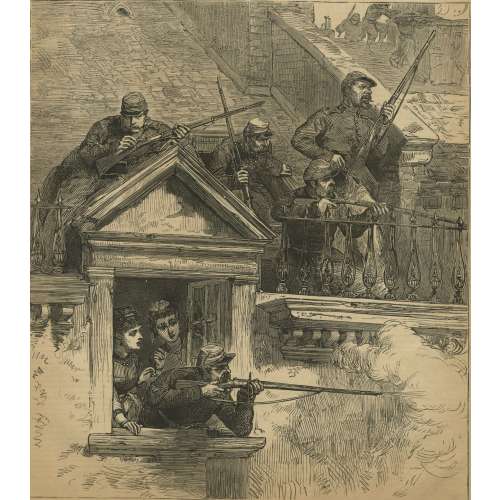
-
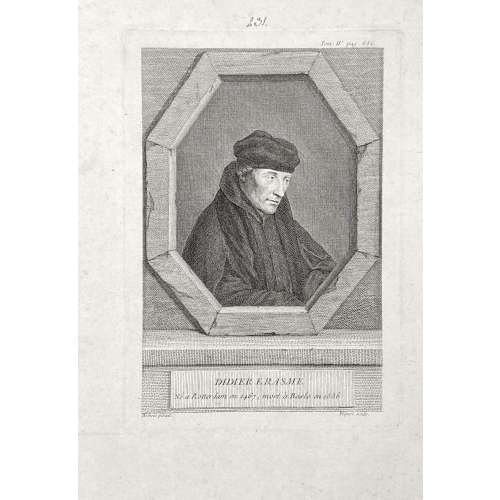 The portrait of Erasmus of Rotterdam (1466 – 1536), half-length, head to the right, body facing right, looking away, in a trompe-l'oeil octagonal frame. Inscriptions: Top right: Tom IV, pag. 686. Center of the image: DIDIER ERASME / Ne a Rotterdam en 1467, mort a Basle en 1536. Bottom of the plate: Holbein pinxit | Flipart Sculp. From the book Histoire générale des Provinces-Unies by Bénigne Dujardin (French, 1689 – 1771?) and Gottfried Sellius (real name Gottfried Sell) (1704? – 1767), published in 1757 in Paris by P. G. Simon. Volume 4, facing p. 686. Size: Sheet: 25 x 17.5 cm; Plate: 19.5 x 13.5 cm; Image: 18 x 12 cm. References: (1) Van Someren v.2, p.249, №1688; (2) https://archive.org/details/histoiregnra04duja/page/n714/mode/2up. Inscription above the plate: nut ink, hand, "231".
The portrait of Erasmus of Rotterdam (1466 – 1536), half-length, head to the right, body facing right, looking away, in a trompe-l'oeil octagonal frame. Inscriptions: Top right: Tom IV, pag. 686. Center of the image: DIDIER ERASME / Ne a Rotterdam en 1467, mort a Basle en 1536. Bottom of the plate: Holbein pinxit | Flipart Sculp. From the book Histoire générale des Provinces-Unies by Bénigne Dujardin (French, 1689 – 1771?) and Gottfried Sellius (real name Gottfried Sell) (1704? – 1767), published in 1757 in Paris by P. G. Simon. Volume 4, facing p. 686. Size: Sheet: 25 x 17.5 cm; Plate: 19.5 x 13.5 cm; Image: 18 x 12 cm. References: (1) Van Someren v.2, p.249, №1688; (2) https://archive.org/details/histoiregnra04duja/page/n714/mode/2up. Inscription above the plate: nut ink, hand, "231". -
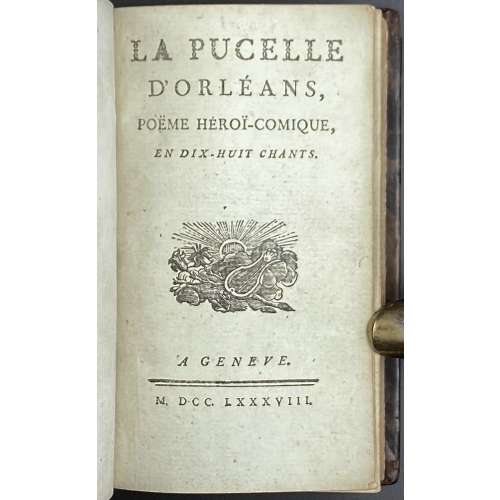 LA PUCELLE | D'ORLÉANS, | POËME HÉROÏ-COMIQUE, | EN DIX-HUIT CHANTS. |{vignette}| A GENEVE. | M. DCC.LXXXVIII.|| Pagination: engraved frontis., engraved portrait, [1, 2] – t.p. / blank, [3] 4-304; plates: engraved frontispiece, engraved portrait of Jeanne d'Arc and 18 engraved plates (the so-called 'suite anglaise' by Marillier, Clément-Pierre (French, 1740 – 1808) after Duflos, Pierre (French, 1742 – 1816). Publisher: Cazin, Hubert-Martin (French, 1724 – 1795). Modern binding to imitate full mottled calf of the 18th century, gilt double-ruled boards, gilt decorated spine with the crimson label “LA PUCELLE”, AEG, laid paper. Size: 13.3 x 8.7 cm; 18mo. Catalogue raisonné: Cohen, De Ricci 1032 (for 1777 and 1780 editions). J. Lewine p.559 (for 1777 16mo and even 12mo editions). The 'correct' 1st thus edition is called suite anglaise because instead of 'chant number' it's printed 'book number' on top of the pages. This copy is definitely a later pirated edition.
LA PUCELLE | D'ORLÉANS, | POËME HÉROÏ-COMIQUE, | EN DIX-HUIT CHANTS. |{vignette}| A GENEVE. | M. DCC.LXXXVIII.|| Pagination: engraved frontis., engraved portrait, [1, 2] – t.p. / blank, [3] 4-304; plates: engraved frontispiece, engraved portrait of Jeanne d'Arc and 18 engraved plates (the so-called 'suite anglaise' by Marillier, Clément-Pierre (French, 1740 – 1808) after Duflos, Pierre (French, 1742 – 1816). Publisher: Cazin, Hubert-Martin (French, 1724 – 1795). Modern binding to imitate full mottled calf of the 18th century, gilt double-ruled boards, gilt decorated spine with the crimson label “LA PUCELLE”, AEG, laid paper. Size: 13.3 x 8.7 cm; 18mo. Catalogue raisonné: Cohen, De Ricci 1032 (for 1777 and 1780 editions). J. Lewine p.559 (for 1777 16mo and even 12mo editions). The 'correct' 1st thus edition is called suite anglaise because instead of 'chant number' it's printed 'book number' on top of the pages. This copy is definitely a later pirated edition. -
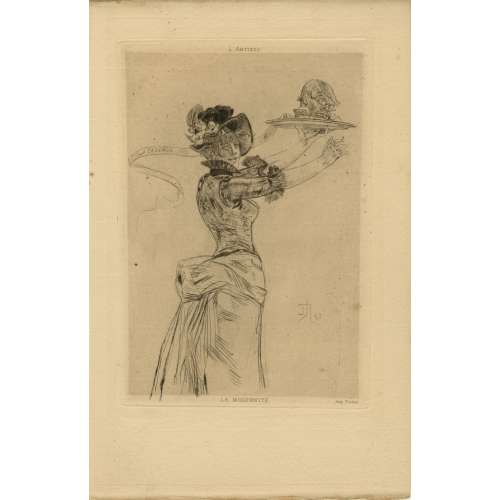
Drypoint on wove paper, depicting a woman in a hat with a ribbon lettered "ACADEMIE", carrying in her hand a male head in spectacles on a plate. Monogrammed "FR 83", inscribed: LA MODERNITÉ. — Imp. Eudes.; in pencil on verso."L'ARTISTE" – OCT. 1886 | (PRUD'HOMME ONTHOOFD) E 332-V". Owner's stamp 'LvM' on verso.
Dimensions: Paper: 27.2 x 17.8 cm; Plate: 19.7 x 14 cm; Image: 18.5 x 13 cm.
Catalogue raisonné: Rouir 767:5; Arthur Hubschmid (1977): 405; Graphics irreverent and erotic (1968): 72.
-
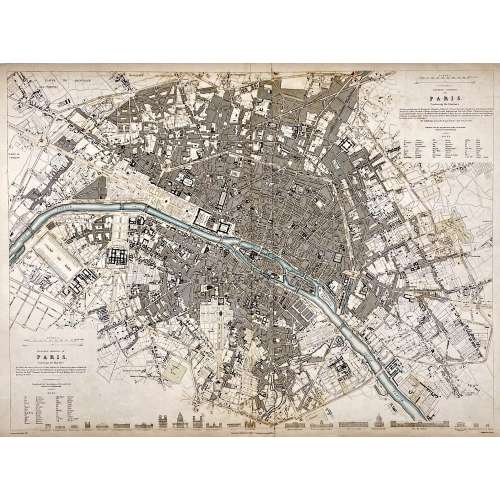 Top right: EASTERN DIVISION OF | PARIS. | Containing the Quartiers | {5 lines in italic} | Published under the Superintendence of the Society for the | Diffusion of Useful Knowledge || Bottom left: WESTERN DIVISION OF | PARIS. | Containing the Quartiers | {4 lines in italic} | Published under the Superintendence of the Society for the | Diffusion of Useful Knowledge || Under the frame: Drawn by W. B. Clarke, Archt. […] Published by Baldwin & Cradock, 47 Paternoster Row, A April 1st, 1834. [...] Engraved by J. Shury || Dimensions: Sheet: 40.8 x 57 cm; Image: 38.7 x 52.5 cm. Contributors: William Barnard Clarke (British, 1806 – 1865) – artist. John Shury (fl. c. 1814-1844) – engraver. Baldwin & Cradock (London) – publisher. Society for the Diffusion of Useful Knowledge (SDUK) (British firm, 1826 – 1846).
Top right: EASTERN DIVISION OF | PARIS. | Containing the Quartiers | {5 lines in italic} | Published under the Superintendence of the Society for the | Diffusion of Useful Knowledge || Bottom left: WESTERN DIVISION OF | PARIS. | Containing the Quartiers | {4 lines in italic} | Published under the Superintendence of the Society for the | Diffusion of Useful Knowledge || Under the frame: Drawn by W. B. Clarke, Archt. […] Published by Baldwin & Cradock, 47 Paternoster Row, A April 1st, 1834. [...] Engraved by J. Shury || Dimensions: Sheet: 40.8 x 57 cm; Image: 38.7 x 52.5 cm. Contributors: William Barnard Clarke (British, 1806 – 1865) – artist. John Shury (fl. c. 1814-1844) – engraver. Baldwin & Cradock (London) – publisher. Society for the Diffusion of Useful Knowledge (SDUK) (British firm, 1826 – 1846). -
 Colour (tone) lithography, image 396 x 508 mm, sheet 532 x 654 mm; before signature, undated; pencil ms inscription: Föhrenhain — E. Pelikan / 200M to the lower-right corner of the sheet. Contributor: Emilie Mediz-Pelikan (Austrian, 1861 – 1908) – artist. Seller's description: Austrian-German painter and graphic artist. Emilie Mediz-Pelikan was born in Vöcklabruck in 1861. She studied at the Vienna Academy and followed her teacher Albert Zimmermann to Salzburg and in 1885 to Munich. In 1891 she married the painter and graphic artist Karl Mediz (1868 - 1945), with whom she lived in Vienna and from 1894 in Dresden. She was in contact with the Dachau Artists' Colony and went on study trips to Paris, Belgium, Hungary and Italy. In the Dachau artists' colony she was friends with Adolf Hölzel and Fritz von Uhde. In 1889 and 1890 she spent time in Paris and in the Belgian artists' colony Knokke. In 1898 she was represented at the first art exhibition of the Vienna Secession, and in 1901 at the International Art Exhibition in Dresden. In 1903 she and her husband had a group exhibition, at the Hagenbund in Vienna. In 1904, she showed graphic works at the Dresden royal court art dealer Richter, and in 1905 and 1906 she exhibited at the Berlin Künstlerhaus. It was not until around 1900 that she achieved her artistic breakthrough with her landscape paintings. Since the estate of the artist, who died prematurely in Dresden in 1908, was lost in the former GDR until the 1980s, it was quite late that the artist was rediscovered and revalued both in Austrian art history and on the art market. In 1986, the first major exhibitions took place at the Upper Austrian State Museum and the University of Applied Arts in Vienna, followed by numerous smaller exhibitions in private galleries in Vienna, Linz and Munich. The artist received recognition during her lifetime from numerous prominent fellow painters as well as from the art critic Ludwig Hevesi. Together with Tina Blau, Herbert Boeckl, Marie Egner, Theodor von Hörmann, Franz Jaschke, Eugen Jettel, Ludwig Heinrich Jungnickel, Rudolf Junk, Gustav Klimt, Oskar Kokoschka, Johann Victor Krämer, Heinrich Kühn, Carl Moll, Rudolf Quittner, Rudolf Ribarz, Emil Jakob Schindler, Max Suppantschitsch, Max Weiler, Olga Wisinger-Florian and Alfred Zoff, she was a protagonist of the reception of Impressionism in Austria. This style went down in Austrian art history under the term "Stimmungsimpressionismus".
Colour (tone) lithography, image 396 x 508 mm, sheet 532 x 654 mm; before signature, undated; pencil ms inscription: Föhrenhain — E. Pelikan / 200M to the lower-right corner of the sheet. Contributor: Emilie Mediz-Pelikan (Austrian, 1861 – 1908) – artist. Seller's description: Austrian-German painter and graphic artist. Emilie Mediz-Pelikan was born in Vöcklabruck in 1861. She studied at the Vienna Academy and followed her teacher Albert Zimmermann to Salzburg and in 1885 to Munich. In 1891 she married the painter and graphic artist Karl Mediz (1868 - 1945), with whom she lived in Vienna and from 1894 in Dresden. She was in contact with the Dachau Artists' Colony and went on study trips to Paris, Belgium, Hungary and Italy. In the Dachau artists' colony she was friends with Adolf Hölzel and Fritz von Uhde. In 1889 and 1890 she spent time in Paris and in the Belgian artists' colony Knokke. In 1898 she was represented at the first art exhibition of the Vienna Secession, and in 1901 at the International Art Exhibition in Dresden. In 1903 she and her husband had a group exhibition, at the Hagenbund in Vienna. In 1904, she showed graphic works at the Dresden royal court art dealer Richter, and in 1905 and 1906 she exhibited at the Berlin Künstlerhaus. It was not until around 1900 that she achieved her artistic breakthrough with her landscape paintings. Since the estate of the artist, who died prematurely in Dresden in 1908, was lost in the former GDR until the 1980s, it was quite late that the artist was rediscovered and revalued both in Austrian art history and on the art market. In 1986, the first major exhibitions took place at the Upper Austrian State Museum and the University of Applied Arts in Vienna, followed by numerous smaller exhibitions in private galleries in Vienna, Linz and Munich. The artist received recognition during her lifetime from numerous prominent fellow painters as well as from the art critic Ludwig Hevesi. Together with Tina Blau, Herbert Boeckl, Marie Egner, Theodor von Hörmann, Franz Jaschke, Eugen Jettel, Ludwig Heinrich Jungnickel, Rudolf Junk, Gustav Klimt, Oskar Kokoschka, Johann Victor Krämer, Heinrich Kühn, Carl Moll, Rudolf Quittner, Rudolf Ribarz, Emil Jakob Schindler, Max Suppantschitsch, Max Weiler, Olga Wisinger-Florian and Alfred Zoff, she was a protagonist of the reception of Impressionism in Austria. This style went down in Austrian art history under the term "Stimmungsimpressionismus".


